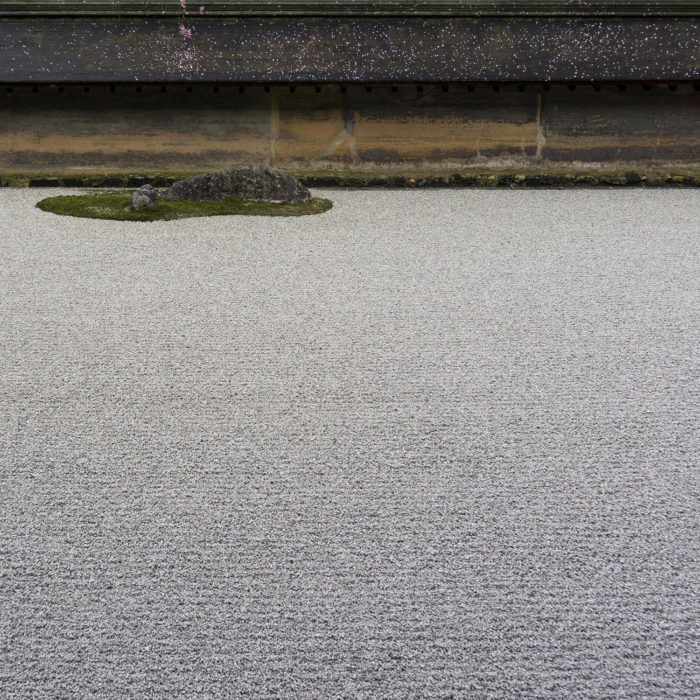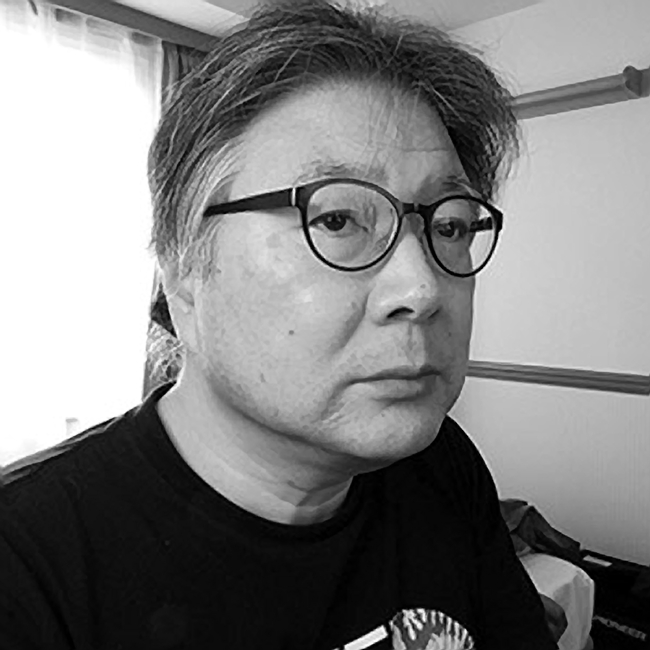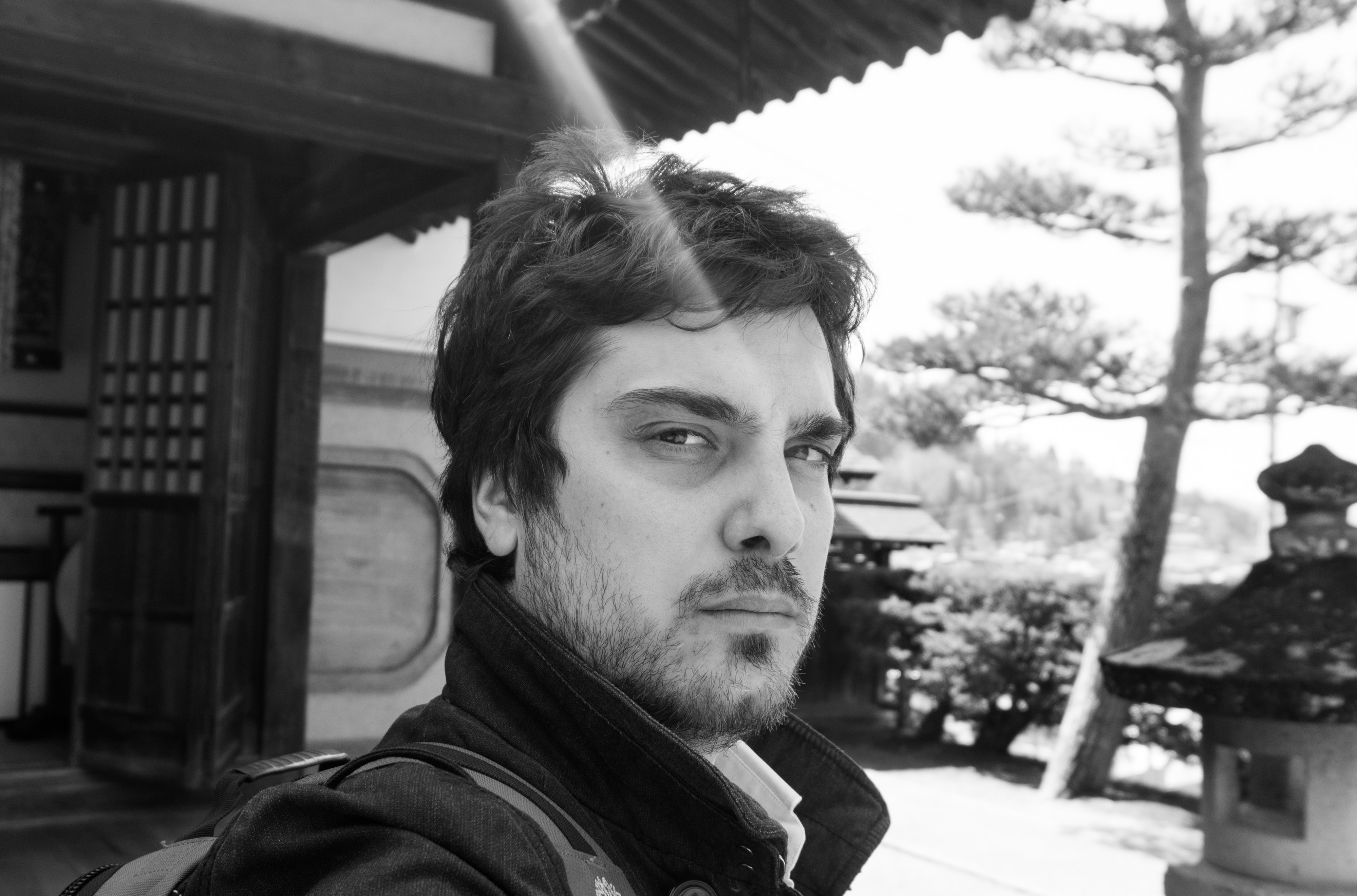Genkai, off Richard Chartier’s fantastic LINE imprint, is the second collaboration of Haruo Okada and Fabio Perletta; as before, Okada acted as field-recordist, collecting material for manipulation, with Perletta forming a composition out of treatments of those materials. The result, which could best be grouped in the much-maligned and ambiguously-defined company of “lowercase”, is perhaps “difficult” in the sense that it will resist a listener approaching with overt expectations. In its highly tactile passages of susurrant ambient noise, articulate percussive taps and rustles, and long stretches of near-silence it becomes something admirable for the patient smoothness of its beauty, despite its open-ended organization. Submerged drifts and ebbs give the impassive sense of inner deliberation from time to time, but for the most part Genkai is devotedly quiet stuff. Okada and Perletta’s work here sates abstract sonic pleasures– rain of rooftops, shoes crunching through dry gravel, the good stuff that’s hard to explicate, in other words. It is undeniably something deliciously beautiful on the whole, as well as one of the most accessible releases I have ever encountered in this vein. Here’s hoping this one doesn’t slip under your radar…
(foreignaccentspdx.com)
A cross between micro-tonal electronics, processed acoustic textures and sound ecology.
Perletta carries on the in depth exploration of aesthetic-ethical ideas related to Zen philosophy. Both artists are receptive to spiritual realms and sensitive to notions such as simplicity, silence, man and nature mutual communication, inner awareness and concrete harmony. Genkai—which means limit, boundary—is at a cross between micro-tonal electronics, processed acoustic textures and sound ecology. The result is abstractly meditative and ateological, largely built on long chordal vibes, timbral sequences, circular motifs and various accidental punctuations. The music suggests a state of tranquility and peacefulness but also of curious and original strangeness. Nothing substantially compelling here but a fine document in electronic minimalism and musique concrète with an original interest for micro soundscaping sceneries. As suggested by one Zen principle “Everything is silent, only the sounds of bells can be heard.”
(igloomag.com)
Era nell’ordine delle cose che uno degli approdi dello studio certosino e sistematico sulle microfrequenze del suono condotto da Fabio Perletta sarebbe stato prima o poi l’uscita su LINE, la storica etichetta di Richard Chartier che dell’esplorazione dell’intorno della soglia dell’udibile ha fatto il suo centro di gravitazione estetica. Da un lato la fascinazione e l’adesione a questo tipo di ricerca, dall’altro l’influenza enorme della cultura (del suono) giapponese, vissuta attraverso studi, letture, ascolti, viaggi, collaborazioni dal sound artist di Roseto degli Abruzzi, confluiscono in questo lavoro a quattro mani con Haruo Okada, articolato su un dialogo tenue tra i field recording catturati da Okada ed il processing digitale di Perletta. Il risultato è un album costruito sulle dinamiche di sottrazione, di levità, di opposizione, di attraversamento liminale nell’intersezione tra le due componenti, in un incastro complesso e suggestivo di elementi microtonali, che tracciano atmosfere ora sognanti ora spettrali. Addensandosi e disaggregandosi intorno al grado zero della materia sonora, questi suoni disegnano traiettorie dissonanti e frantumate nello spazio dell’ascolto, che diventa lo scenario acustico di un’esperienza intensa e immersiva. L’ascolto in cuffia permette di cogliere in tutto il suo spessore e la sua profondità il senso di un lavoro immaginato ed assemblato nelle sue componenti (la spazialità, anzitutto) come una vera e propria opera scultorea di sound art. (8)
(Blow Up, IT)
Though artistic expression through gardening and landscape design is common in many cultures, it is the Japanese, with their dry gardens, who have produced some of the artform’s most eloquent and aesthetically articulate examples. Many dry gardens take their design inspiration from classic narratives or poems, though to those unfamiliar with the references being made, their scrupulous precision and austerity can seem mysterious or obtuse. Yet even the eyes of the unversed in classical Japanese and Chinese literature can appreciate how a dry garden can change its appearance depending on the time of day, the weather, and the season, and also be transformed over time through the effects of weathering. How formal exactness can give rise to such openness, subtlety, and change is arguably one of the key questions of Japanese aesthetics, as Allen S. Weiss proposes in his book Zen Landscapes.
It is also a concern that is implied in Haruo Okada and Fabio Perletta’s new album “Genkai”. Okada’s recordings of metallic clangs and clatters, tappings, crackings, and thumpings, flutterings of wings, ploppings, shakings, and many other sounds have been set with great precision and care in a bed of electronic whispers, bleeps, and tones by Perletta. It’s all very subtle and quiet, which gives an ambiguity and ephemerality to the sounds. Sometimes there are faint chords, and on one occasion a single note from a guitar and from a piano, but it’s all very low-key and not at all obviously narrative or emotional.
Listening for some kind of pattern, or trying to figure out the logic of the recorded sounds’ placement in silence and faint tone, would seem to be as pointless as trying to guess at the narrative behind the design of a Japanese dry garden such as Ryōan-ji. No, perhaps not pointless — though as much an occasion for the free play of imagination as for deducing deeper meaning from sonic facts. But “Genkai” proves as malleable by factors outside its control as a dry garden does, sounding different in the morning compared with the evening, or in a rain storm compared with sunshine. To a large extent it’s an empty vessel, its only offering an enjoinder to listen.
(fluid-radio.co.uk)
Abbiamo già scritto di Fabio Perletta, che è curatore dell’etichetta Farmacia 901 e fa parte dell’Archivio Italiano Paesaggi Sonori. È un’ottima notizia per l’arcipelago italiano dell’elettronica d’ascolto il fatto che quest’anno lui sia approdato su Line, nello specifico con un disco realizzato a quattro mani assieme ad Haruo Okada, che scopro essere sound designer alle dipendenze della Pioneer. Perletta, da quanto posso capire, è innamorato del Giappone e in effetti questa sua collaborazione con Okada non sembra basata solo su affinità musicali in senso stretto, ma frutto di un suo percorso di ricerca più ampio e di lungo periodo. “Il silenzio è un elemento fondamentale che io taglio coi suoni. Come nell’architettura giapponese, lo spazio vuoto è l’elemento più importante”. Me lo ha detto Mika Vainio quando l’ho intervistato e m’è tornato in mente con questo disco, seppure con una differenza fondamentale, cioè l’assoluta mancanza di “pan-sonicità” in Genkai, che – come spiega l’etichetta – significa “limite”. Il gioco col silenzio, però, è lo stesso del finlandese: quando il suono entra in scena, è come se potessimo ammirarlo in tutto il suo splendore, perché è come se uscisse dal buio completo dopo che i due hanno levato di mezzo ogni possibile distrazione. In più, come si desume dall’essenzialità dell’insieme, il limite di cui sopra è autoimposto e sta proprio nel quantitativo (sempre bassissimo) di elementi utilizzati per creare le cinque tracce del disco, a loro volta divise in più quadri: Okada fornisce il materiale sonoro, Perletta lo assembla e processa, in un certo senso – per dirla di nuovo con Vainio – sistemandolo all’interno di uno spazio da lui progettato. Genkai è uno di quei dischi che sono esigenti con l’ascoltatore: vuole cuffie, attenzione e pazienza. Dopo di che non diventa il preferito di nessuno, ma regala di sicuro piccole epifanie. Ho già usato questa frase una volta giorni fa e c’entrava sempre un orientale, la riciclo per Genkai: se vi dico che è roba facile, non mi credete, fidatevi però che – se vi sforzate di entrare dentro il lavoro – le soddisfazioni arrivano.
(thenewnoise.it)
Translucent in sound, Haruo Okada and Fabio Perletta explore the subtle nuance of sound with Genkai 限界. Absolutely pristine the textures feel positively tactile in tone. Within this sonic environment it is the small gestures that are truly celebrated. Effortlessly combining elements of field recordings, microsound, and digital debris throughout the pieces hum with life. By opting for a bright and shiny approach to the sound the duo creates a fully engrossing world, letting the pieces breathe.
Mere murmurs introduce the delicate “Genkai 1-6”. A shimmering sound begins to emerge from the near silence. They let a light yet steady bass into the mix before eventually opting for the higher register pitches. From there pieces of the surroundings filter their way into the mix giving the textures greater depth. Pastoral in performance “Genkai 7-9” goes for a naturalistic sound. Exploration of space occurs throughout the piece as elements simply fade off into the horizon. On “Genkai 11 + 10” a Zen-like calm dominates the proceedings. Here even the slightest movement has a tremendous impact on the overall approach. Easily the highlight of the album is the transformative work of “Genkai 12 – 17 + 19” where musical instruments are woven into the mix further emphasizing the sound’s oftentimes fleeting nature. Closing it off in a contemplative mood is the serene introspective mood of “Genkai 18 + 20-21”.
Pure perfection, Haruo Okada and Fabio Perletta let the small sounds sing their song on Genkai 限界.
(beach sloth.tumblr.com)
Il secondo incontro tra il nostro Fabio Perletta (titolare della label Farmacia901) e Haruo Okada (ben noto in Giappone per i suoi lavori di sound art e di sincronizzazione) è un lavoro di rigore ultra-minimalista, che concilia elettronica digitale ai limiti dello spettro udible e field recording, attraverso un raffinato dosaggio di elementi e una riflessione metodologica basata sulla contrapposizione di opposti. Chi è pratico di musica acusmatica potrà trovare in Genkai (in Genkai 1–6 in particolare) le sollecitazioni tipiche delle installazioni sonore: l’utilizzo del suono per delimitare e descrivere lo spazio, la forza evocativa dei “suoni trovati”. Genkai è un’esperienza immersiva potente, per chi ama le sottili vibrazioni dell’arte complessa del sound environment.
(Rumore, IT)



